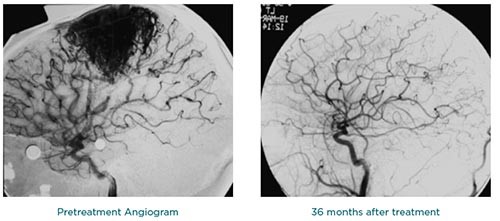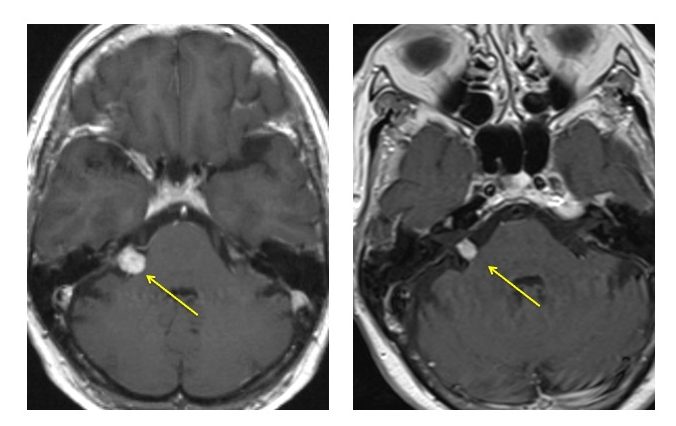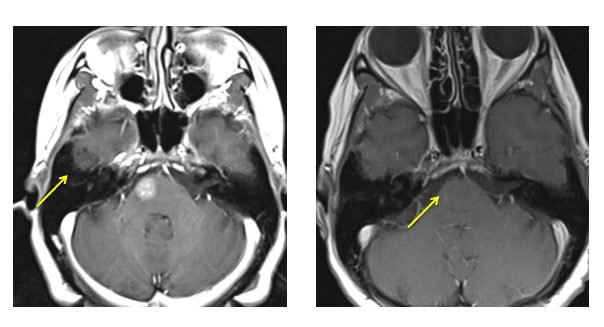Request an Appointment
Please call our office at 816-363-2500 to make an appointment. Don’t forget to bring your imaging studies with you.
What is Stereotactic Radiosurgery And How Does The Gamma Knife Work?
Stereotactic Radiosurgery: focused radiation that Is used to accurately treat brain tumors and other conditions, while sparring radiation to surrounding healthy tissues.
The Gamma Knife Icon is an alternative to traditional brain surgery and radiation therapy for the treatment of complex, difficult to treat brain conditions. The Gamma Knife is not a knife, but rather a sophisticated system that can be used to replace brain surgery or whole brain radiation therapy in some situations. It uses gamma radiation delivered by up to 192 individual beams, which intersect at a single spot with an accuracy of less than one-tenth of a millimeter (about the thickness of a sheet of paper). The Gamma Knife can be used to treat targets even in the most critical, difficult-to-access areas of the brain while sparing nearby healthy tissue. The Gamma Knife can be used to shrink or prevent additional growth of brain lesions without opening the skull, without general anesthesia, and without the need for an overnight hospital stay.
The newest Gamma Knife Icon offers multiple radiosurgery options including treatment with or without a head frame and single or multiple treatment sessions in order to specifically tailor the best form of radiation treatment for your specific tumor or condition.
Who needs gamma knife radiosurgery?
Radiosurgery can be used to treat patients with benign or malignant brain tumors, arteriovenous malformations (AVM’s) of the brain, trigeminal neuralgia and tremor.
Indications for radiosurgery include, but are not limited to:
- A lesion located within a critical brain region in which an open skull operative approach would be likely to cause a significant neurological deficit
- A recurrent or persistent tumor that was not eradicated by open neurosurgery or has not responded to external beam radiation
- Multiple brain tumors (metastatic disease)
- A medical condition that places a patient at unacceptably high risk for anesthesia and open surgey
- Advanced age.
- A patient who does not wish to undergo traditional brain surgery
In many circumstances, Gamma Knife radiosurgery can control a brain tumor or eliminate an AVM just as well as conventional surgery, but with a lower risk of complications. Gamma Knife radiosurgery is not intended to replace conventional neurosurgery but is an effective additional weapon in our arsenal for combating AVM’s and brain tumors and for relieving facial pain and tremor. Gamma Knife treatment may serve as an adjunct to standard neurosurgical therapy or as the preferred course of treatment when traditional surgery is not recommended.
Conditions treated with the Gamma Knife
Arteriovenous Malformations (AVMs)
Arteriovenous Malformations are made up of abnormal arteries and veins, which form prior to birth. AVM’s may cause headaches, seizures or bleeding within the brain. AVM’s can be treated in order to reduce or eliminate the risk of spontaneous bleeding that may cause permanent brain injury. Current treatment options for AVM’s include open skull surgery, radiosurgery and embolization or combination thereof. Obliteration (closing off) of the AVM vessels after Gamma Knife radiosurgery usually occurs gradually over a time period of two to three years. Approximately 80% of patients will achieve complete obliteration (range between 60% and 95%, depending on AVM size), with the option for re-treatment after three to five years in patients with residual AVM. Temporary side effects such as weakness, numbness, imbalance or vision loss may occur in 10 to 15 percent of all cases. Permanent neurological problems occur in fewer than five percent of patients. Since AVM vessels close gradually after Gamma Knife treatment, there is a small risk of spontaneous bleeding from the AVM during the early years after treatment. Periodic MRI scans are usually requested at one year intervals to monitor your progress. An angiogram is usually obtained three years after treatment for definitive evaluation.

Acoustic Neuroma (Vestibular Schwannoma)
Gamma Knife radiosurgery is an excellent alternative to conventional open skull surgery for acoustic tumors. Acoustic neuromas are benign tumors of the eighth cranial nerve. These tumors usually cause hearing loss, ringing in the ear or balance problems. Gamma Knife radiosurgery can prevent further tumor growth or shrink the tumor in more than 90 percent of patients. Useful hearing, (if present prior to treatment) can be preserved about 50 percent of the time, but progressive hearing loss may occur after treatment. Permanent numbness or weakness of the face is very rare and occurs in fewer than one percent of patients. Your doctor will review possible risks and side effects as they relate to tumor location. Since there is a small risk of tumor progression or delayed recurrence after treatment, your progress will be monitored with MRI scans every one to three years.

Metastatic Brain Cancer
Brain metastasis is the most common indication for Gamma Knife radiosurgery. Radiosurgery for metastatic brain tumors may be used in conjunction with other therapies including conventional open skull surgery and radiation therapy, depending on the size, location and number of tumors. More than one tumor can be treated during a single Gamma Knife session. Gamma Knife treatment provides tumor control (no growth or tumor shrinkage) in about 90 percent of patients. Gamma Knife radiosurgery alone can be as effective as surgery and whole brain radiation therapy and eliminates the need for hospitalization and multiple treatments. Please ask your doctor about the possible side effects of treatment as they relate to the specific type and location of your tumor. Since there is a small risk for recurrence at previously treated sites and a possibility of developing new brain metastasis after treatment, your progress will be monitored closely with MRI scans every three to six months.

Trigeminal Neuralgia (Face Pain)
Trigeminal Neuralgia causes unpredictable, repeated attacks of severe face pain and is often provoked by normal activities such as eating and talking.Over time the attacks usually become more frequent and persistent. Neurosurgical treatments for trigeminal neuralgia include open skull surgery for Microvascular Decompression (repositioning an artery away from the affected nerve), Percutaneous Balloon Compression (needle procedure performed under brief general anesthesia) and Gamma Knife radiosurgery. Facial pain usually improves within four weeks after gamma knife treatment in about 90% of treated patients. Trigeminal neuralgia may recur in about 30% of individuals after five years. Patients who experience pain recurrence frequently respond to resumption of medication or can opt for repeat Gamma Knife or an alternative neurosurgical procedure. Uncomfortable numbness of a portion of the face which may occur 6-18 months after treatment in about 5% of individuals. Your doctor will review all available therapies and help you decide which type of treatment would be best for your individual circumstance.
Other Brain Tumors
Other brain tumors that may benefit from Gamma Knife® radiosurgery include glioblastoma multiforme, oligodendroglioma, astrocytomas, meningiomas, pituitary tumors, and skull base tumors. Patients should consult with their doctor to determine if they are a candidate for this specialized treatment.
Tremor
Gamma Knife radiosurgery may be used to treat patients with disabling hand tremor due to Benign Essential Tremor, Parkinson’s disease or Multiple Sclerosis. Tremor cells within the thalamus are targeted and destroyed by the radiation. Excellent or good relief of tremor is seen in up to 80% of individuals. Other treatment options for tremor include deep brain stimulation. Your doctor will review all available therapies and help you decide which type of treatment would be best for your individual circumstance.
Before the Procedure
The Gamma Knife team which includes specially trained neurosurgeons, radiation oncologists, neuro-oncologists, physicists, neuroradiologists and nurses will review your medical records and recent images to determine if you would be a good candidate for Gamma Knife Radiosurgery. You and your referring physician will be contacted once the Gamma Knife team has decided that the procedure is right for you.
Prior to treatment, a Gamma Knife neurosurgeon, radiation oncologist and nurse will meet with you in order to discuss the procedure and answer your questions. You should not eat or drink anything after midnight on the night before treatment in order to decrease the chance of stomach upset during the procedure.
Scan Results
The Gamma Knife Icon offers treatment with or without a head frame. On the morning of treatment a nurse will start an intravenous (IV) line to administer a mild sedative prior to head frame placement. After the sedative takes effect, a local anesthetic is administered and the guiding device (stereotactic head frame) will be attached to your head with four temporary pins. No hair will be shaved. Any mild discomfort experienced at the time of frame application is transient. An MRI or CT scan will be performed and the appropriate images selected and transferred to the Gamma Plan computer workstation.
Angiograms are obtained in patients with vascular malformations.
Dose planning
Dose planning usually takes one to two hours, depending on the size and location of the lesion. During the planning process you can rest, read, visit with family, listen to music or even take a nap. After the radiation dose plan is completed and reviewed by the Gamma Knife team, you will be moved to the Gamma Knife couch for treatment.
Radio-surgery Machine
This bed slides into the radiosurgery machine and the head frame is securely attached to a helmet in the machine. The treatment session usually lasts from thirty minutes to three hours, depending on the amount of radiation necessary and the geometry and location of the target(s). You will not feel or hear anything during the treatment. Throughout the treatment, you will be observed by closed circuit video, and you will be able to communicate with your doctors and nurses via two-way intercom.
After Treatment
After treatment, the head frame (if used) will be removed and you can return home after brief observation. The pin sites where the head frame was attached will heal within 24 hours and you may shampoo your hair the day after treatment. If multiple treatment sessions are recommended, you will be instructed when to return on the following day.
Radiation is Complete
You can return to your normal routine, without restrictions, on the day after treatment.
The benefits of Gamma Knife radiosurgery occur over a period of time that can range from several weeks to several years, depending on the condition being treated. MRI scans will be requested at regular intervals in order to monitor the effectiveness of the treatment. We will contact you to remind you when these tests are due. Because many patients live outside of the Kansas City area, the Gamma Knife team will rely on you and your referring physician to have the necessary tests done at the appropriate times.
What happens after radiotherapy?
After an hour, most patients can go home, and are free to drink and eat.
Most patients resume their normal routines the day after gamma knife radiosurgery.
This material is intended to give the patient an overview of surgical procedures and treatments and is not intended to replace the advice and guidance of a physician. Always consult with your doctor about the particular risks and benefits of your treatment.
Request an Appointment
Please call our office at 816-363-2500 to request an appointment.
If you have had any studies, such as MRI scans, CAT scans, arteriograms, electromyograms (EMG), or plain x-rays, please bring them with you to your appointment.



 The Highest Quality of Neurosurgical Care
The Highest Quality of Neurosurgical Care